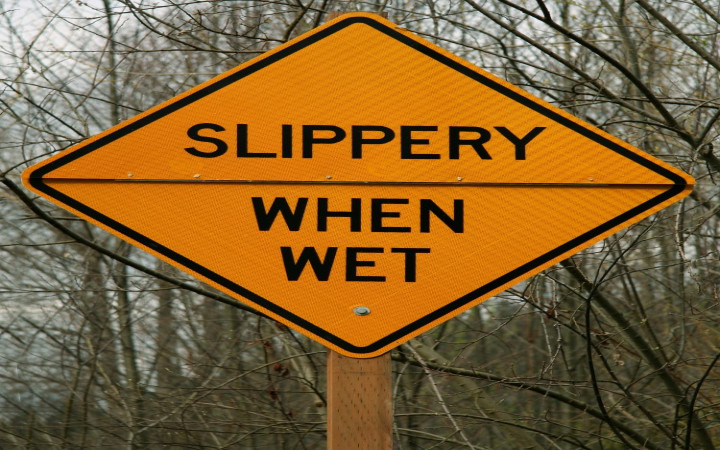Where Is It More Likely to Be Slippery

SCIENCE — Physical Science
Have You Ever Wondered...
- Why are roads slippery when wet?
- Can roads be slippery during the summer?
- What precautions should you take when you drive on wet roads?
Do you ever gaze out the car window while your parents are driving you to and from school, church, or soccer practice? As the road signs fly by, do you ever WONDER what all those numbers and interesting symbols mean?
There's one sign, in particular, that you may have seen from time to time. It usually looks like a car with a couple squiggly lines underneath it. What could this funny-looking sign mean? Caution: earthworms ahead? Don't drive over spaghetti? Bacon will make your car fly?
While all those are funny possibilities, that curious sign actually means slippery when wet. It's a reminder to drivers to be extra-careful when driving during or shortly after it rains.
If you've ever played in the street during or after a rainstorm, you may be skeptical about such a warning. After all, a wet street probably doesn't seem all that slippery when you're in your tennis shoes. Why would it be dangerous to drive on?
Before examining the effects of water on a road, let's first take a look at what force helps to keep cars on the street and drivers in control. When rubber tires meet the road, their motion across the road creates a force known as friction.
For example, the weight of a car pushing down on its tires pushes the rubber of the tire into the thousands of tiny pits that make up a typical road surface. Vibrations from the road surface combine with the deformation of the rubber to create heat, producing friction that helps the tires "stick" to the road.
When it rains, the water on a road causes a loss of friction. As tires move over a wet surface, the water fills in the tiny pits in the road surface, effectively smoothing out the surface. As a result, the normal heat and friction created is decreased, leading to a surface that is more slippery than when dry.
If there's a lot of water on the road, including standing water in puddles, even more severe loss of friction can occur. In these cases, a car's tires can completely lose contact with the road surface as they surf along on a thin layer of water. When this occurs, it's called hydroplaning, and it can be very dangerous.
There are also substances on roads that can lead to a loss of friction when water is added. For example, most dry roads contain a layer of tar, rubber, and oil. When it starts to rain, these substances can mix with the water, creating a greasy layer that can be very slippery.
So what can you do to prevent accidents when you're driving in wet conditions? The first rule of driving on potentially-slippery surfaces is slow down! Feel free to drive well below the speed limit if necessary to help maintain control of your vehicle. If it is raining severely and hydroplaning is a possibility, pull over to the side of the road until conditions improve. Lastly, make sure your tires are in good condition and properly inflated.
Wonder What's Next?
Tomorrow's Wonder of the Day is all about change!
Try It Out
We hope you had fun slipping and sliding through today's Wonder of the Day. Find a friend or family member to help you check out the following activities:
- What kind of stuff can you find on your street? Grab a magnifying glass and go have an up-close look at the street in front of your house (but be careful not to stand in the actual road!). What do you see? Does it feel slippery at all? Bring a cup of water with you. Pour it on the street and then see what changes you notice. Does the wet surface feel more slippery than it was when it was dry? Have fun investigating scientific principles in your own neighborhood!
- Ask an adult friend or family member to take you for a long drive around your area. Drive on different kinds of roads, including city streets, gravel roads, and highways. Drive through a few small towns and even through some out-of-the-way spots. Pay attention to the signs you see. Do you understand all of them? Ask your driver about any signs you don't understand. You never know what you'll learn on a leisurely drive!
- Want to learn more about friction and how it works? Try these Simple Friction Experiments at home with a friend or family member. Can you apply what you learn in these experiments to situations in the world around you?
Did you get it?
Test your knowledge
Related Wonders for You to Explore


Quit Select a Word
Quit
Drag a word to its definition
Word Match
Select a Wonder Word:
slippery
rain
surface
wet
car
pit
friction
warning
road
water
Word Match
Congratulations!
You've matched all of the definitions correctly.
Exit
Quiz Results
Not Bad
You have answered 0 of 3 questions correctly and your score is:
Share Results
Where Is It More Likely to Be Slippery
Source: https://www.wonderopolis.org/wonder/why-are-roads-slippery-when-wet
Post a Comment for "Where Is It More Likely to Be Slippery"